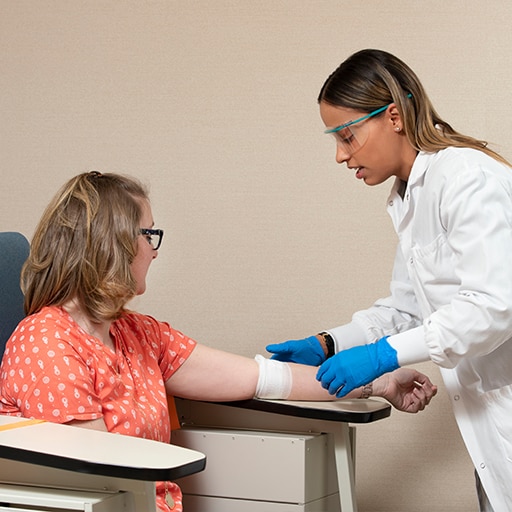Getting My Northeast Medical Institute - New Haven Campus Phlebotomy Course & Cna Class To Work
Getting My Northeast Medical Institute - New Haven Campus Phlebotomy Course & Cna Class To Work
Blog Article
How Northeast Medical Institute - New Haven Campus Phlebotomy Course & Cna Class can Save You Time, Stress, and Money.
Table of ContentsAbout Northeast Medical Institute - New Haven Campus Phlebotomy Course & Cna ClassWhat Does Northeast Medical Institute - New Haven Campus Phlebotomy Course & Cna Class Do?Our Northeast Medical Institute - New Haven Campus Phlebotomy Course & Cna Class PDFs6 Easy Facts About Northeast Medical Institute - New Haven Campus Phlebotomy Course & Cna Class ShownNortheast Medical Institute - New Haven Campus Phlebotomy Course & Cna Class for DummiesThe Single Strategy To Use For Northeast Medical Institute - New Haven Campus Phlebotomy Course & Cna Class
The use of such devices should be gone along with by other infection prevention and control techniques, and training in their use.For settings with low sources, expense is a driving factor in purchase of safety-engineered gadgets. Where safety-engineered tools are not offered, experienced usage of a needle and syringe is appropriate.
In the blood-sampling area for an outpatient division or center, give a comfortable reclining couch with an arm remainder.
6 Easy Facts About Northeast Medical Institute - New Haven Campus Phlebotomy Course & Cna Class Shown
Make certain that the signs for blood sampling are plainly defined, either in a composed method or in documented instructions (e.g. in a research laboratory type). Whatsoever times, adhere to the strategies for infection avoidance and control provided in Table 2.2. Infection prevention and control methods. Gather all the equipment required for the treatment and location it within safe and very easy reach on a tray or trolley, ensuring that all the things are clearly noticeable.
Introduce on your own to the patient, and ask the patient to mention their complete name. Inspect that the lab form matches the patient's identification (i.e. match the client's details with the lab form, to make sure accurate recognition).
Make the client comfortable in a supine position (when possible). Area a tidy paper or towel under the individual's arm. Review the test to be performed (see Annex F) and acquire verbal permission. The client has a right to decline an examination at any moment before the blood sampling, so it is vital to ensure that the patient has actually understood the treatment.
10 Easy Facts About Northeast Medical Institute - New Haven Campus Phlebotomy Course & Cna Class Described
Expand the individual's arm and inspect the antecubital fossa or forearm. Find a blood vessel of an excellent size that is visible, straight and clear.
DO NOT place the needle where veins are drawing away, since this raises the chance of a haematoma. The capillary must show up without applying the tourniquet. Finding the vein will help in figuring out the right dimension of needle. Apply the tourniquet regarding 45 finger sizes above the venepuncture site and re-examine the vein.
Haemolysis, contamination and presence of intravenous fluid and medicine can all change the results (39. Nursing team and physicians may access central venous lines for specimens following methods. Specimens from main lines lug a danger of contamination or erroneous laboratory test results. It serves, however not optimal, to injure samplings when very first introducing an in-dwelling venous tool, before attaching the cannula to the intravenous liquids.
Little Known Facts About Northeast Medical Institute - New Haven Campus Phlebotomy Course & Cna Class.
Failing to allow enough get in touch with time boosts the threat of contamination. DO NOT touch the cleaned up site; in specific, DO NOT position a finger over the blood vessel to direct the shaft of the subjected needle.
Ask the person to form a clenched fist so the next page capillaries are more prominent. Get in the capillary quickly at a 30 level angle or much less, and remain to present the needle along the capillary at the most convenient angle of access - PCT Classes. As soon as enough blood has actually been collected, launch the tourniquet BEFORE withdrawing the needle
The Basic Principles Of Northeast Medical Institute - New Haven Campus Phlebotomy Course & Cna Class
Withdraw the needle delicately and use gentle pressure to the site with a clean gauze or completely dry cotton-wool sphere. Ask the client to hold the gauze or cotton woollen in place, with the arm extended and raised. Ask the patient NOT to bend the arm, because doing so causes a haematoma.

The Definitive Guide to Northeast Medical Institute - New Haven Campus Phlebotomy Course & Cna Class
Where feasible, keep the tubes in a rack and move the shelf in the direction of you - https://www.mixcloud.com/northeastmed/. If the sample tube does not have a rubber stopper, inject extremely slowly into the tube as reducing the pressure and speed utilized to transfer the sampling lowers the danger of haemolysis.

Report this page